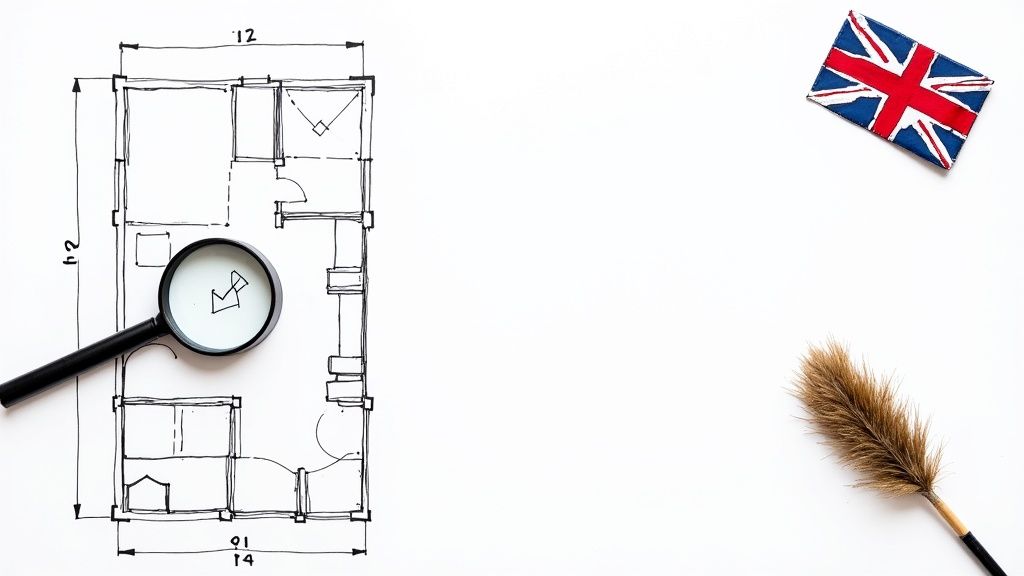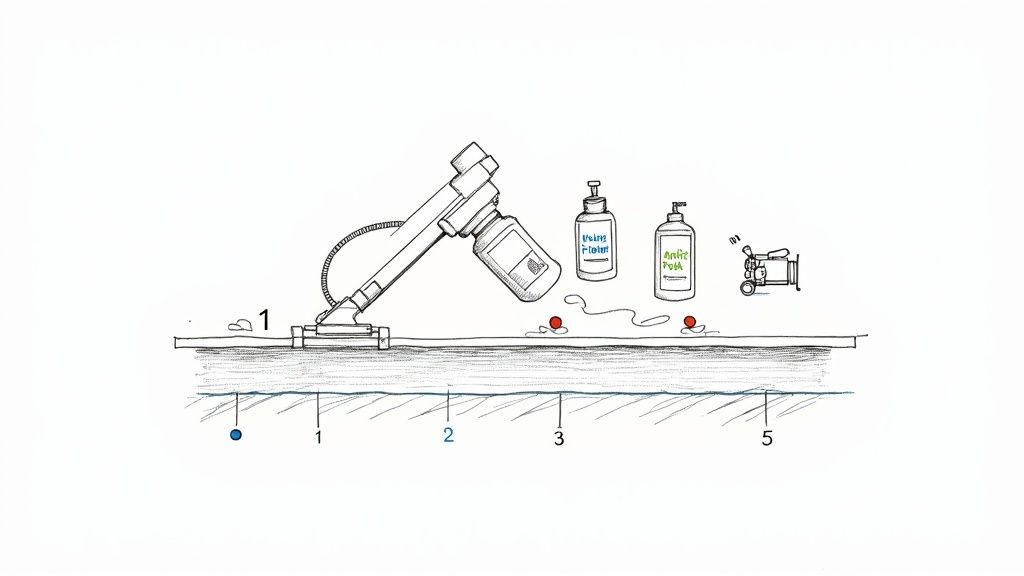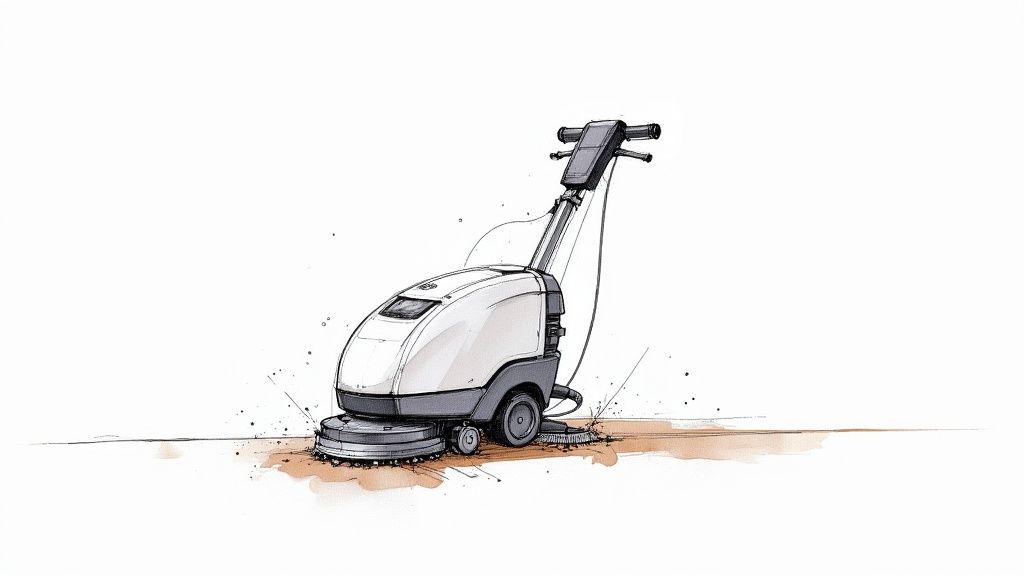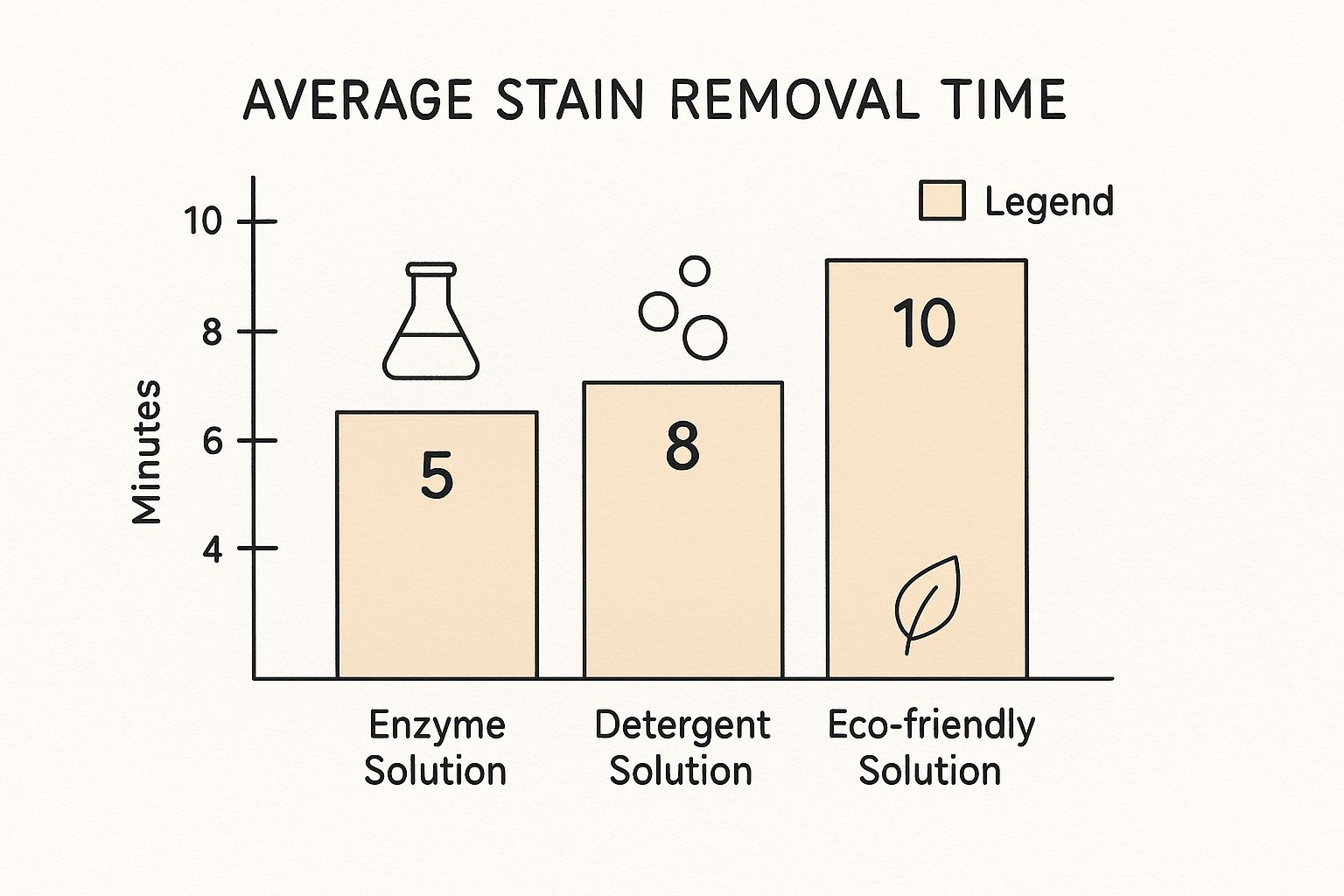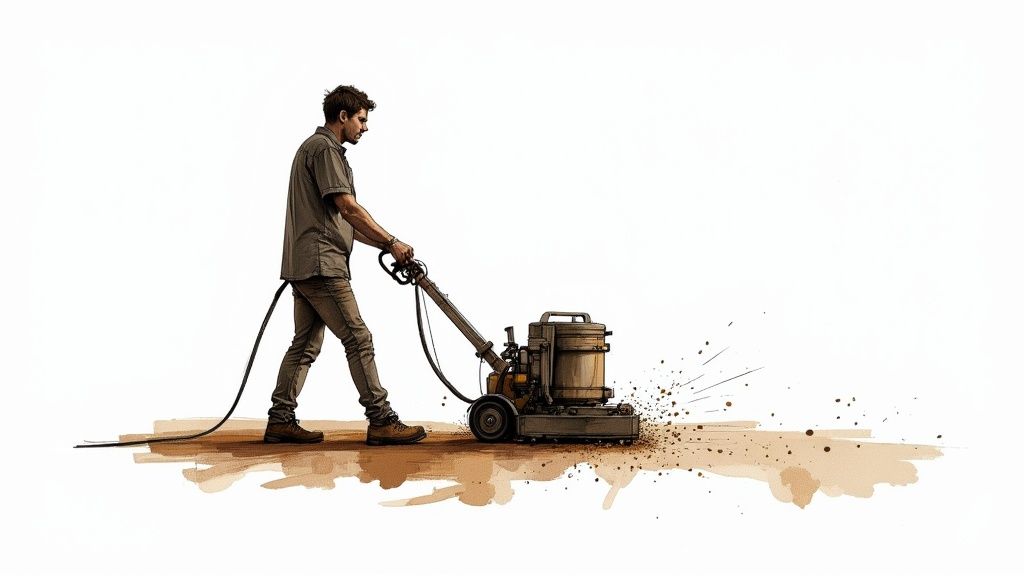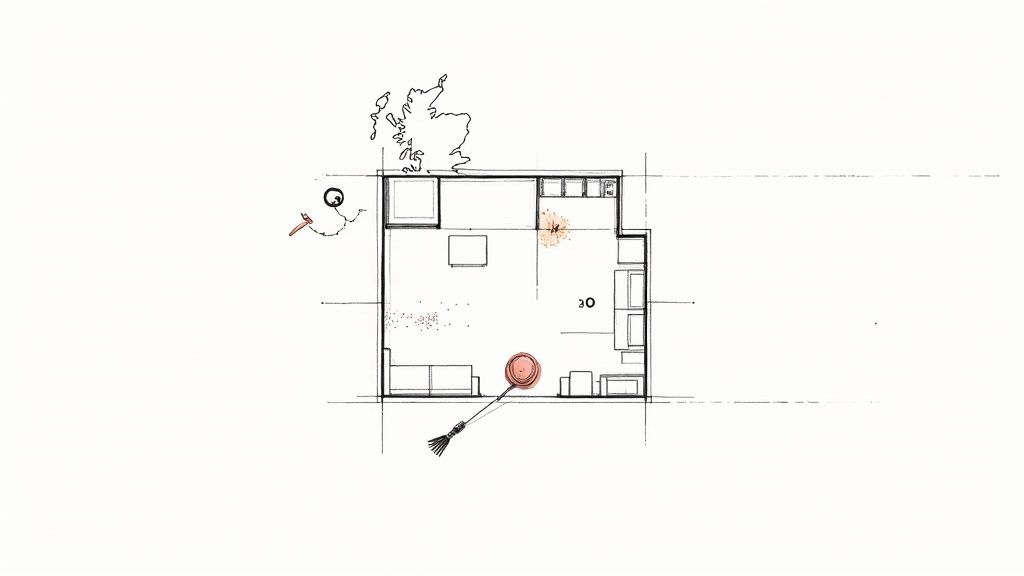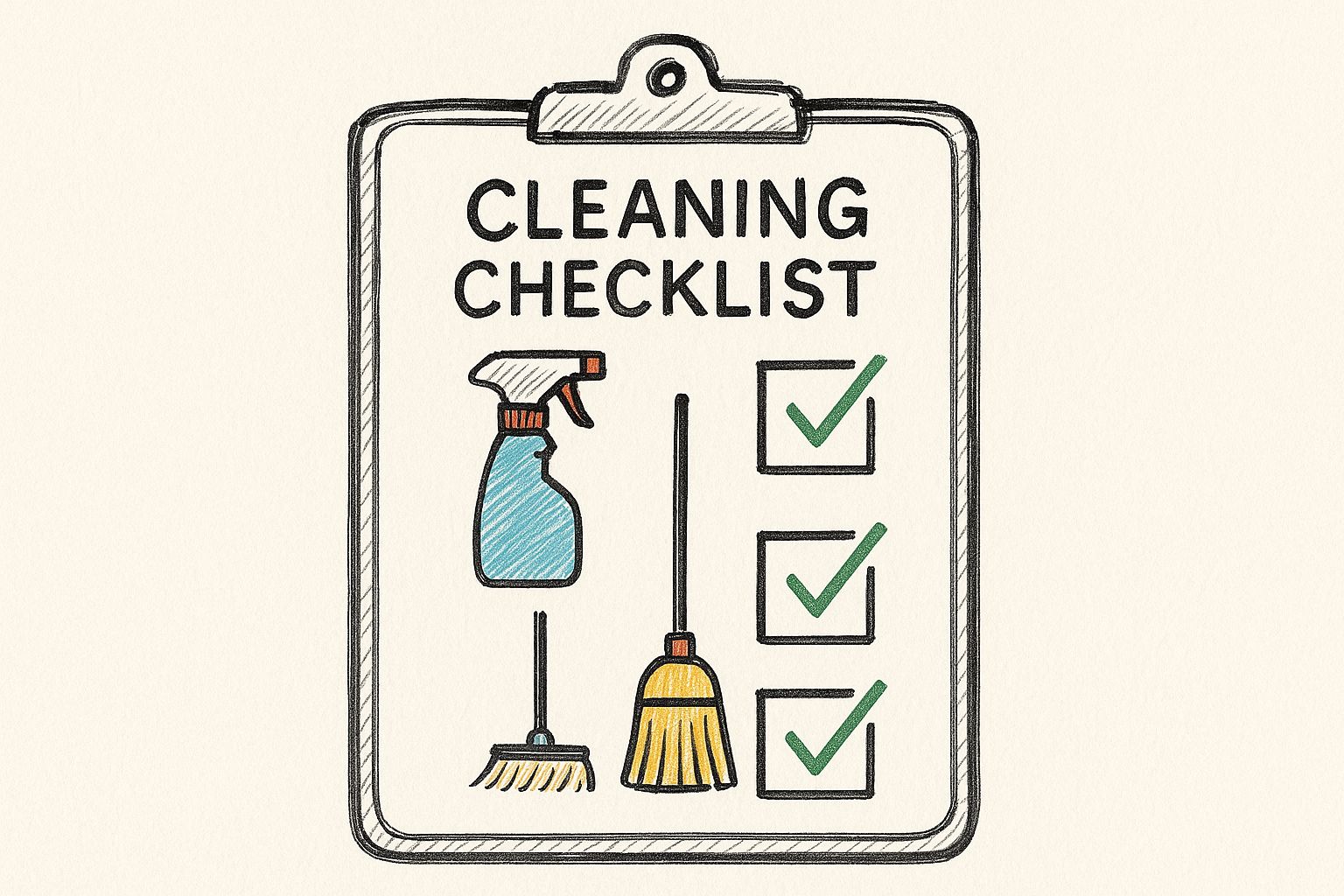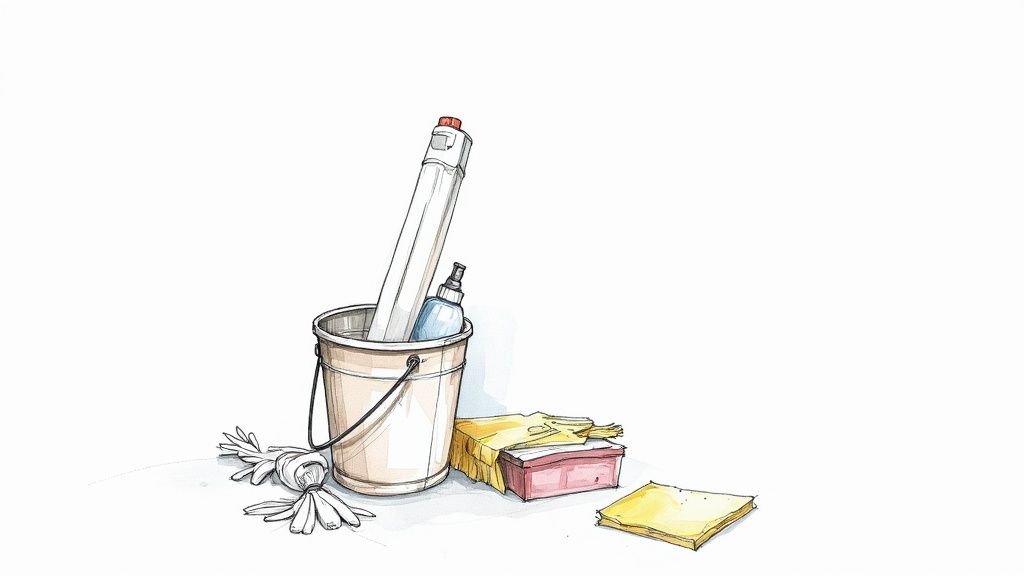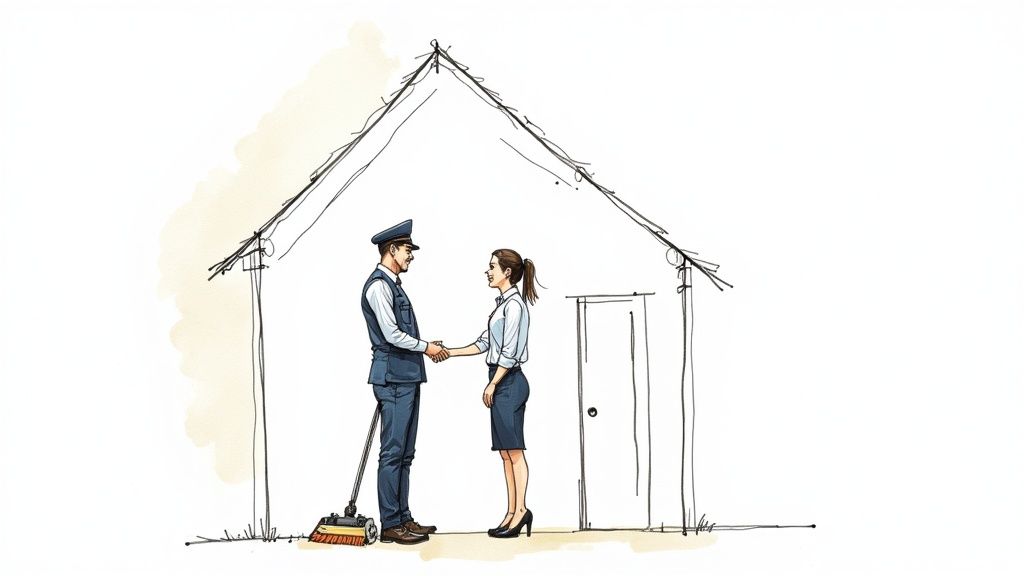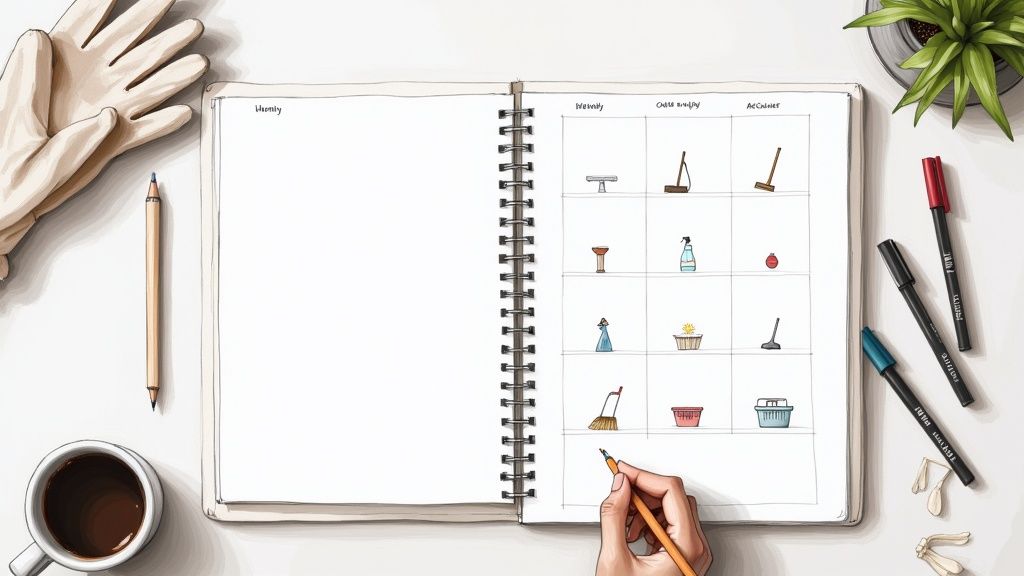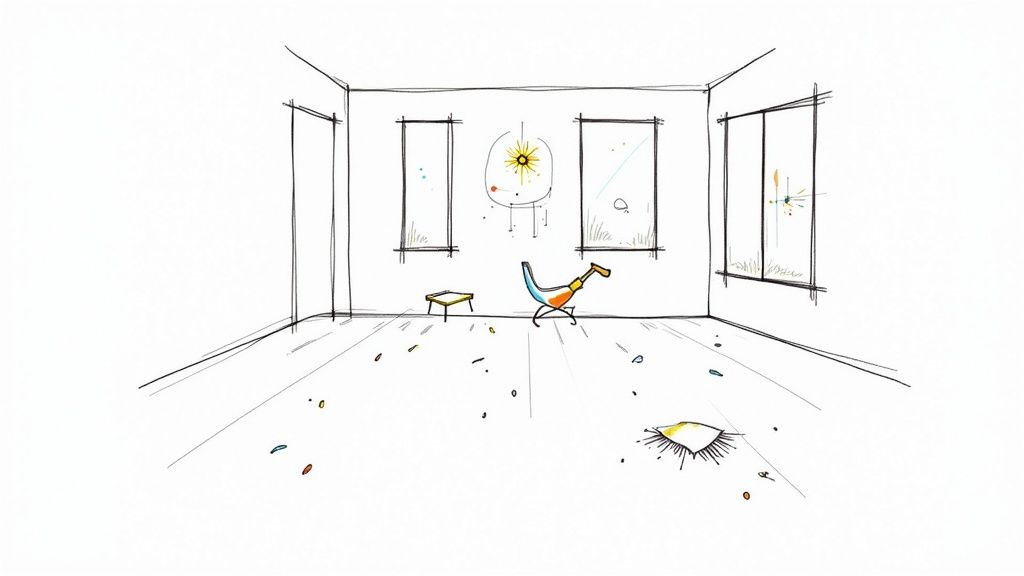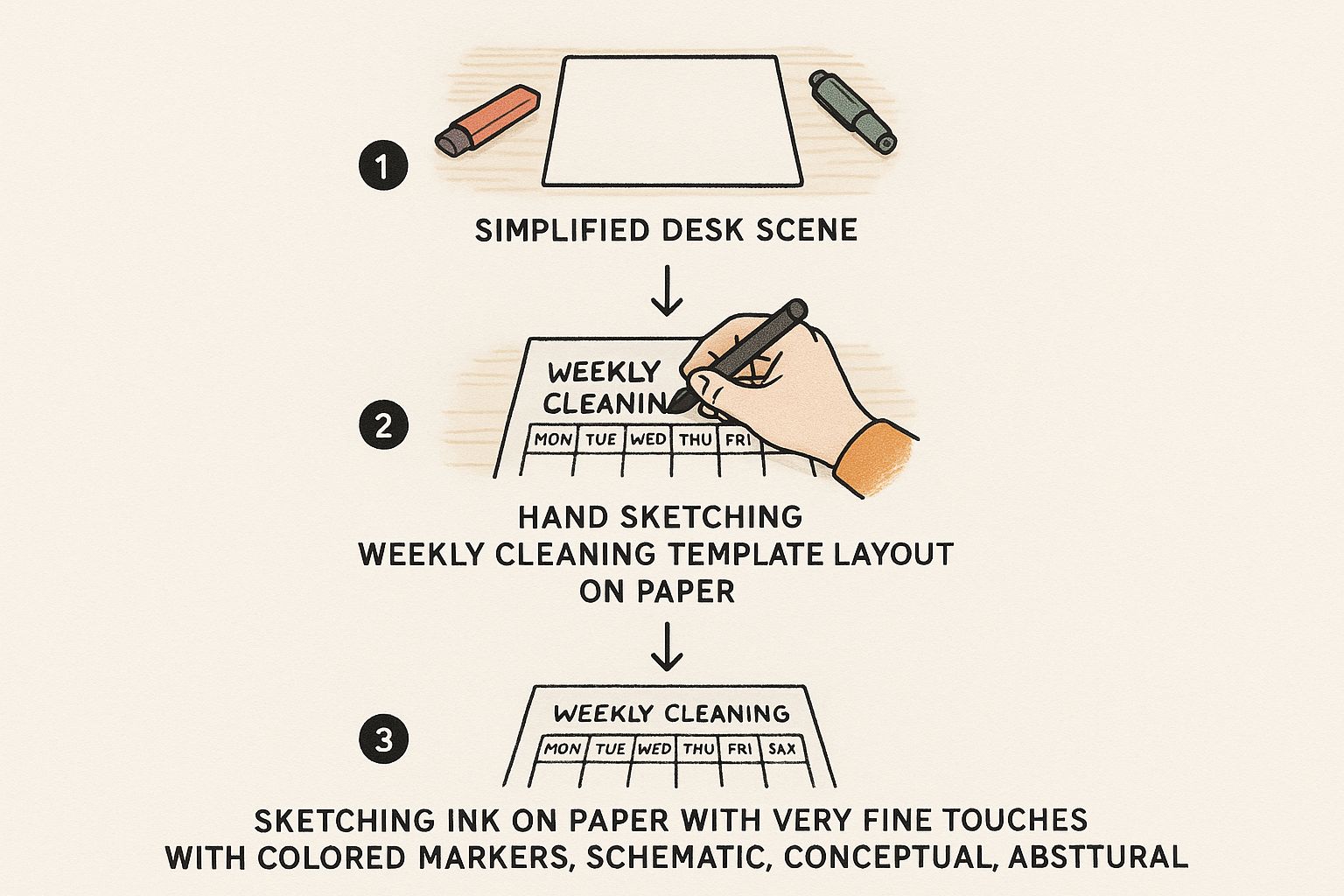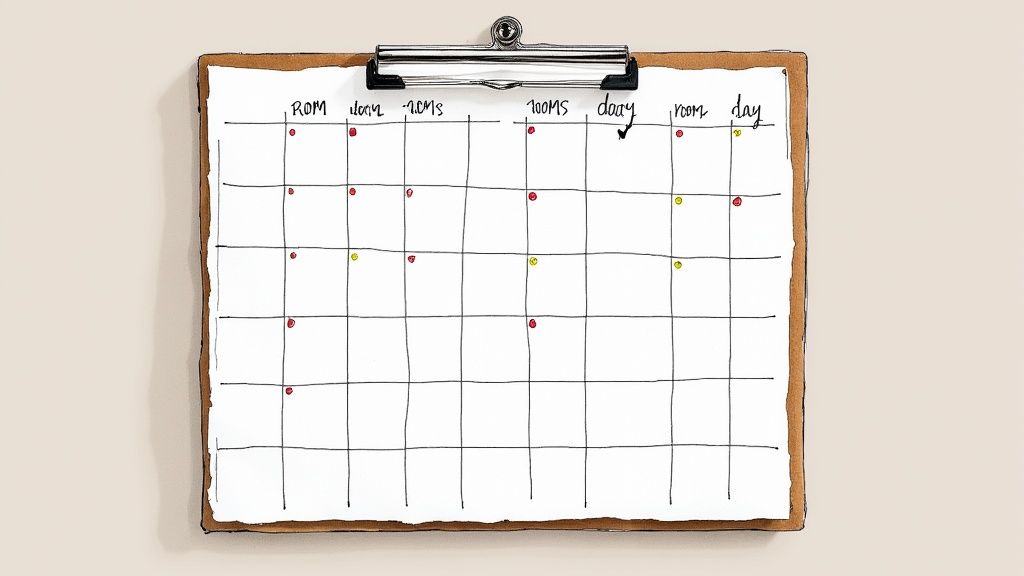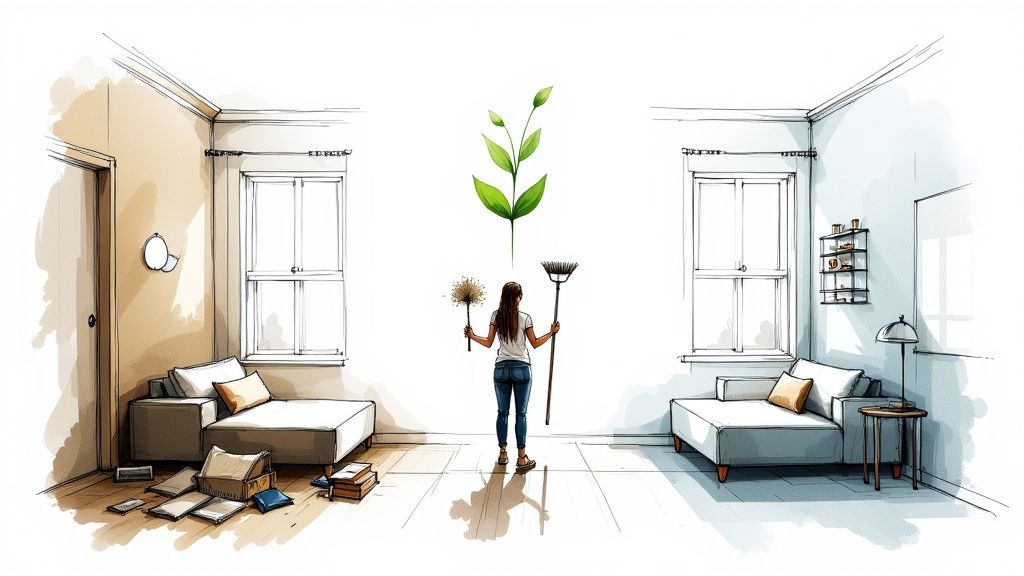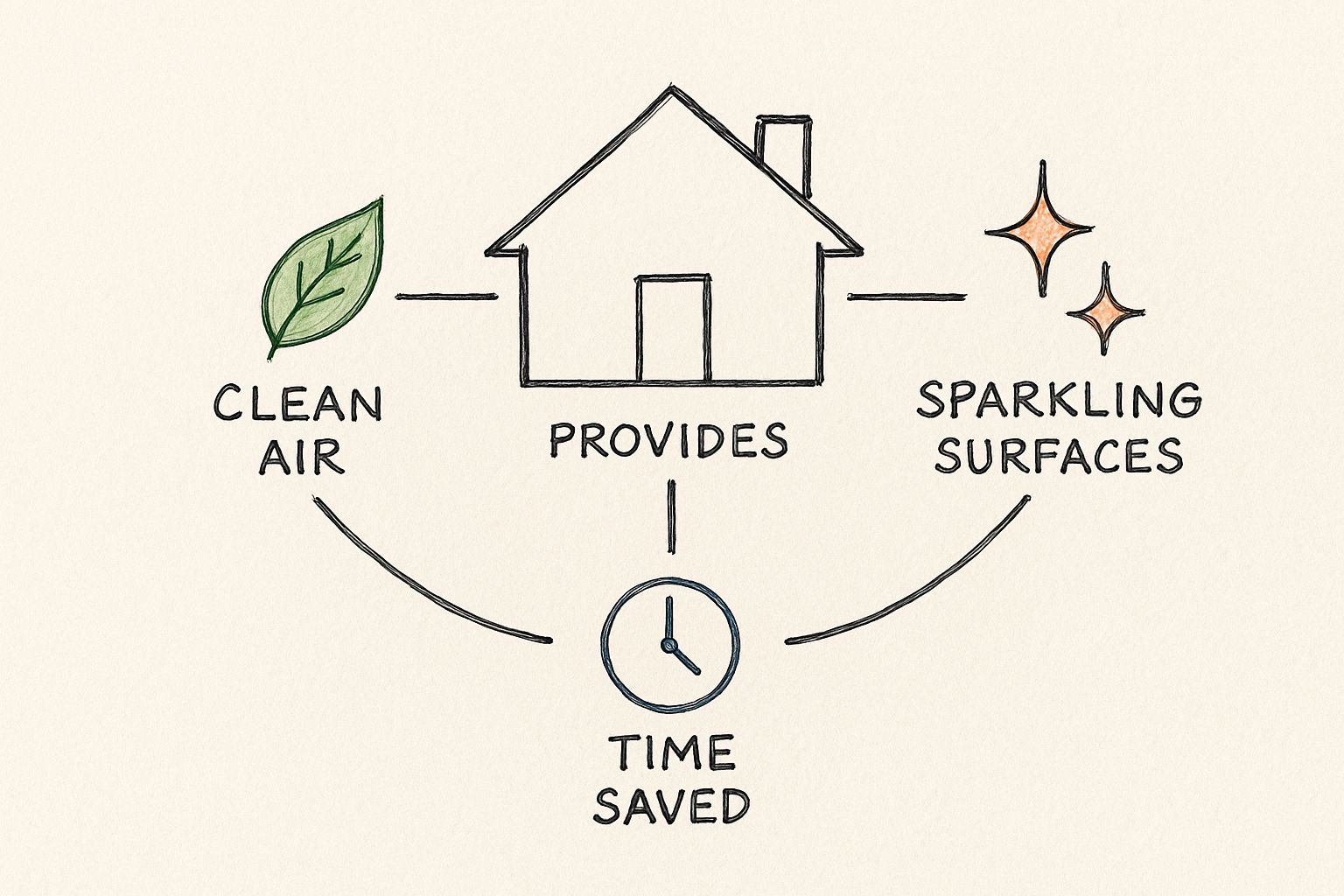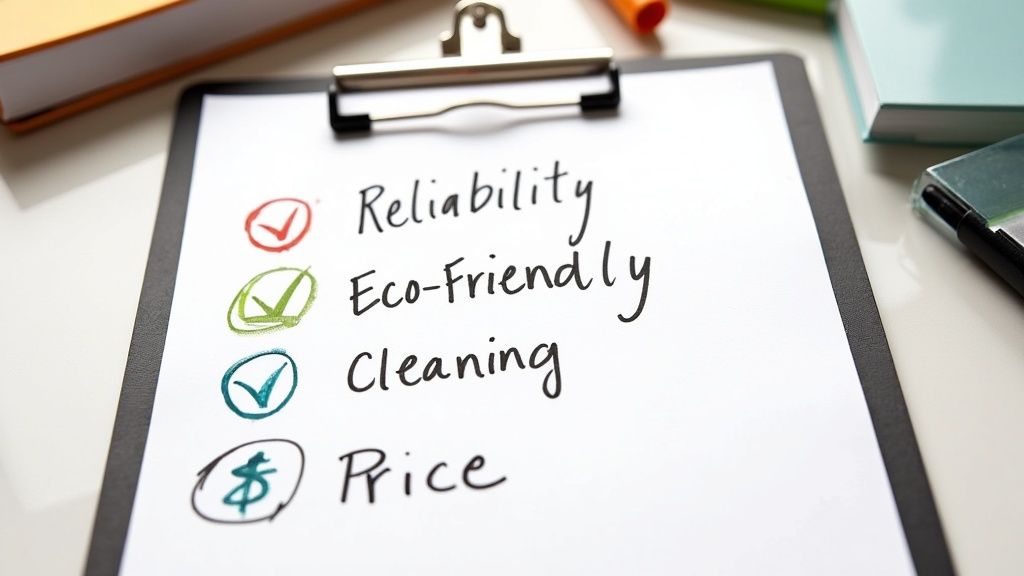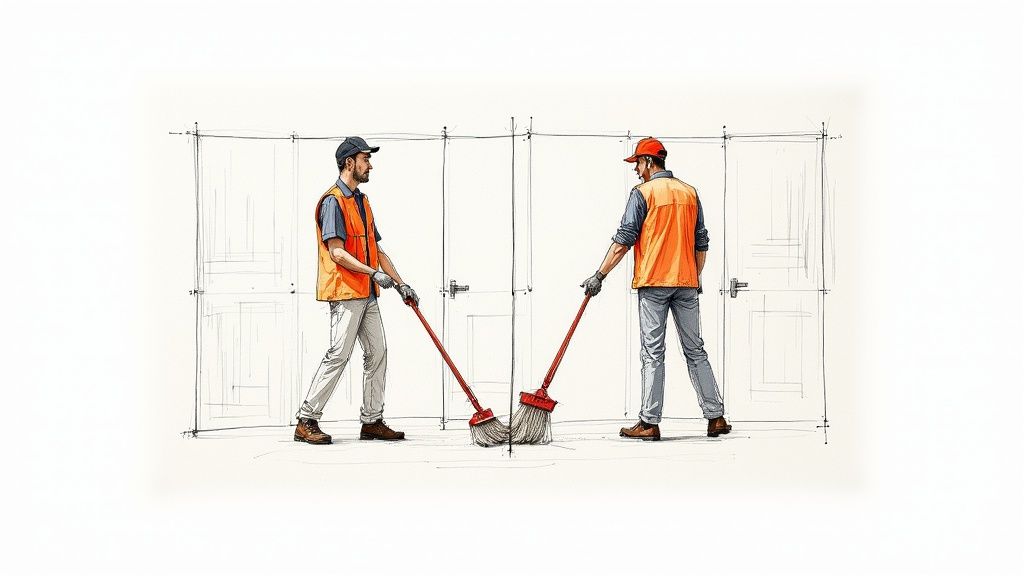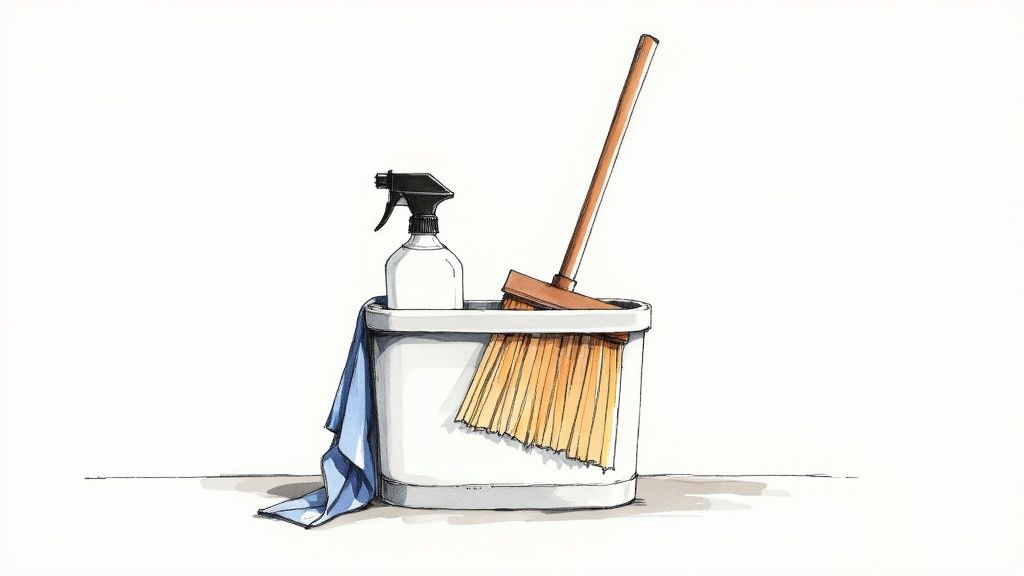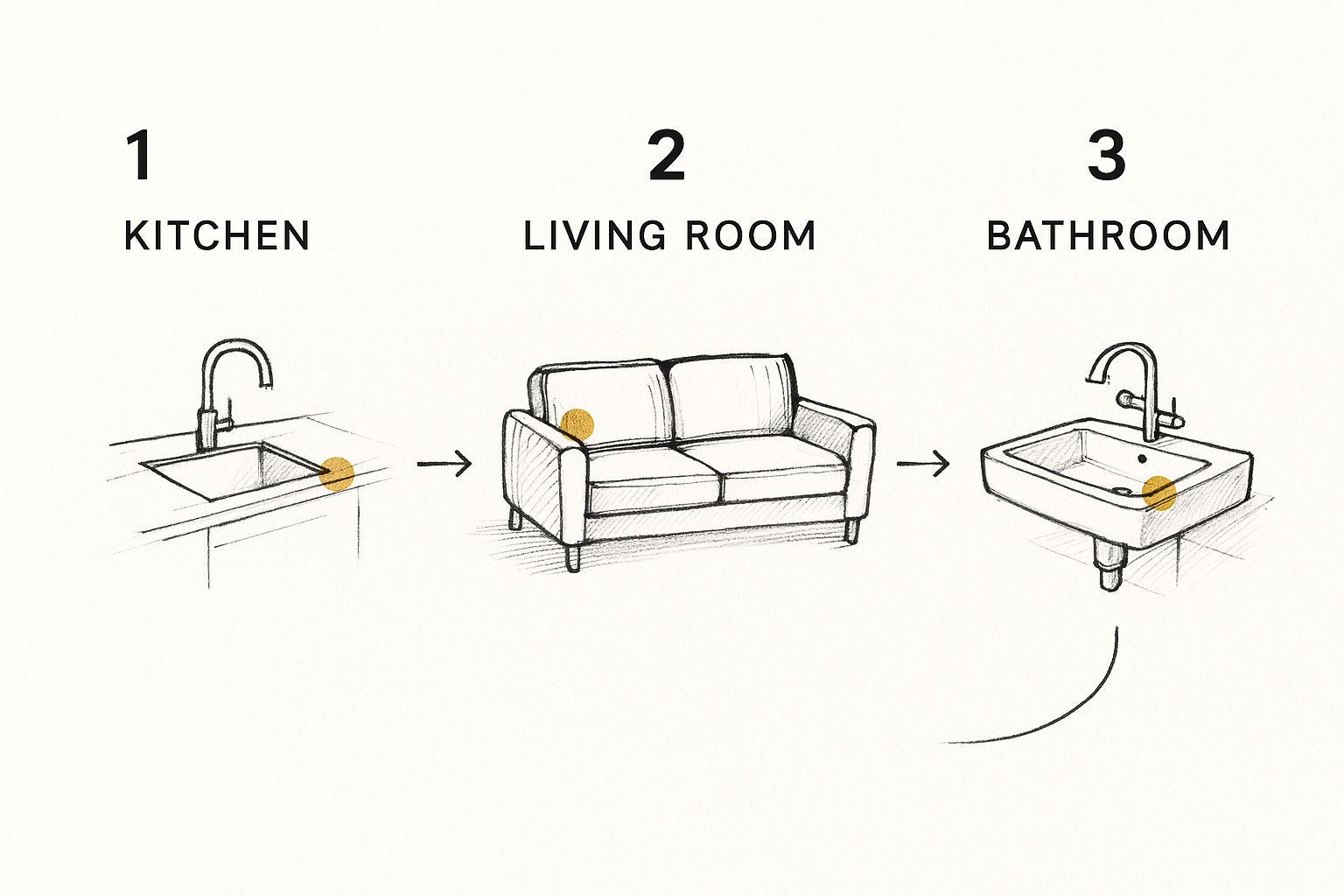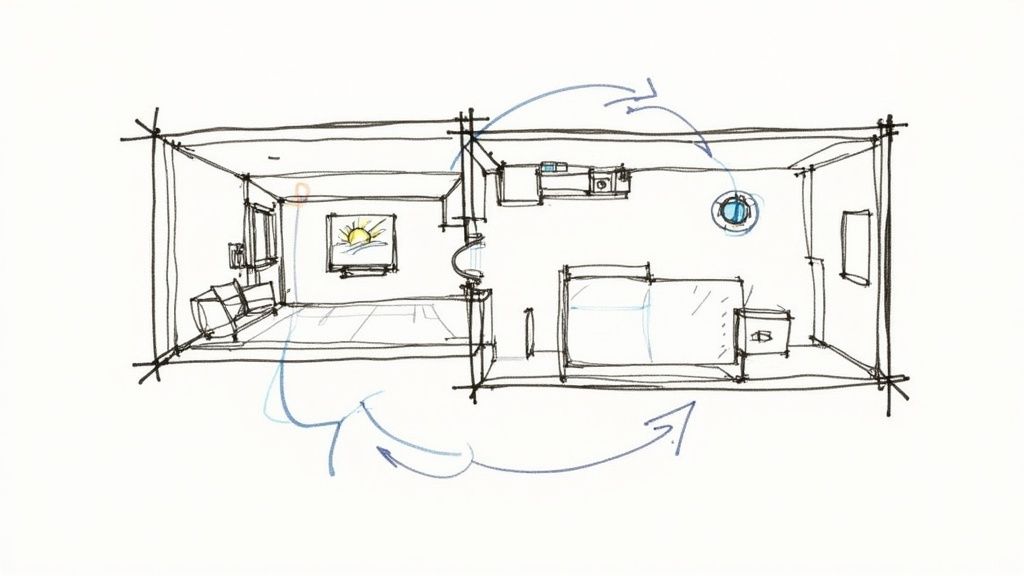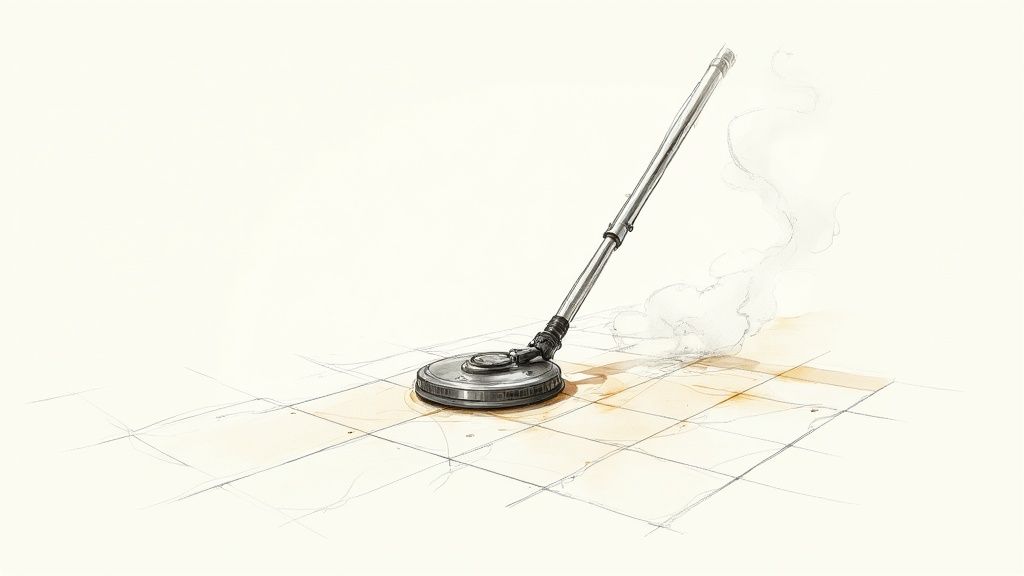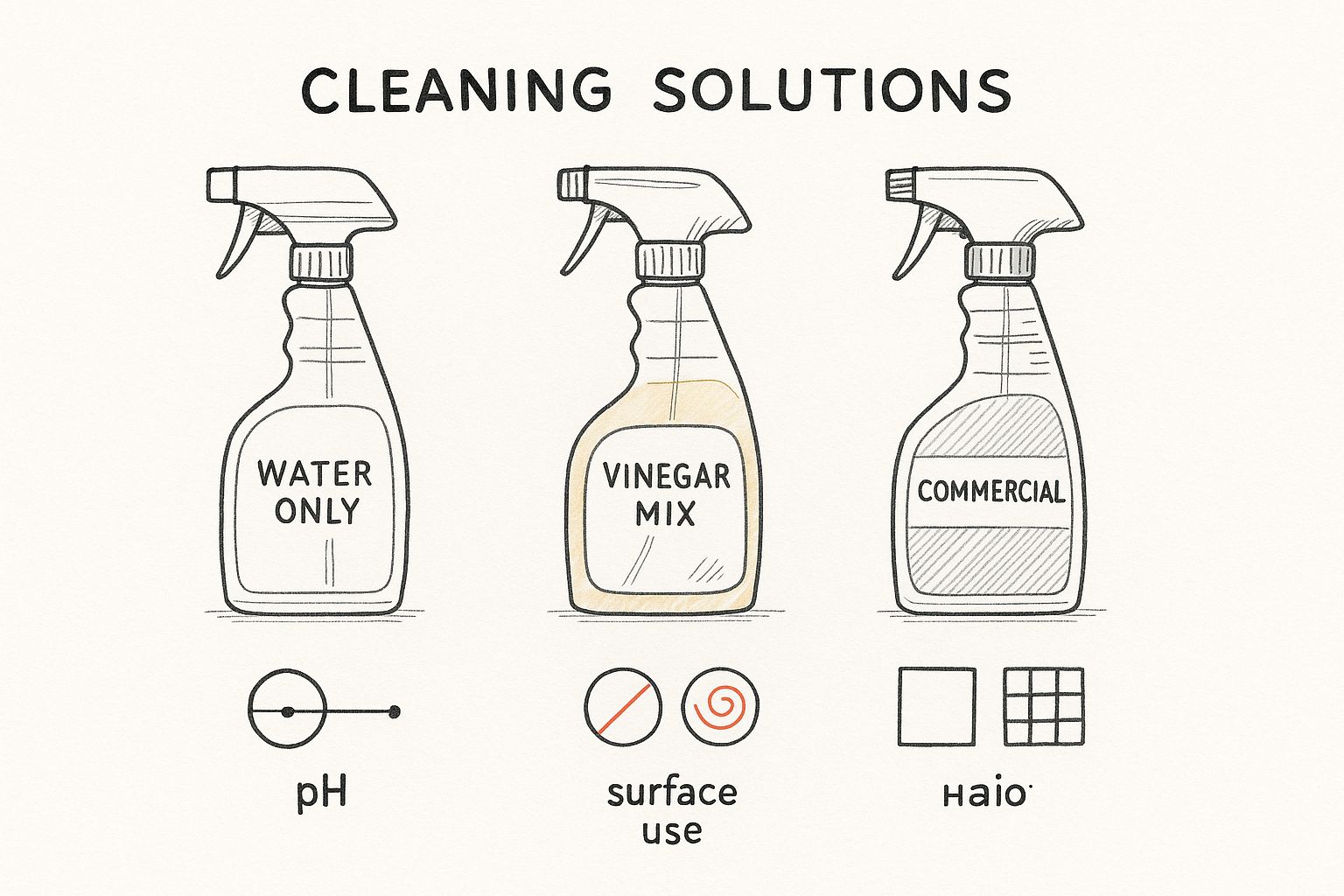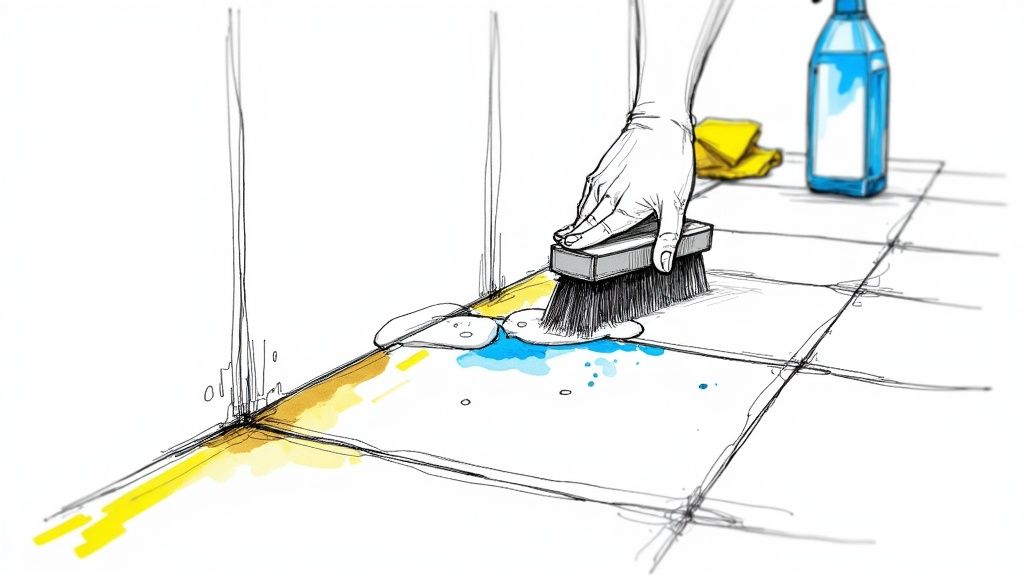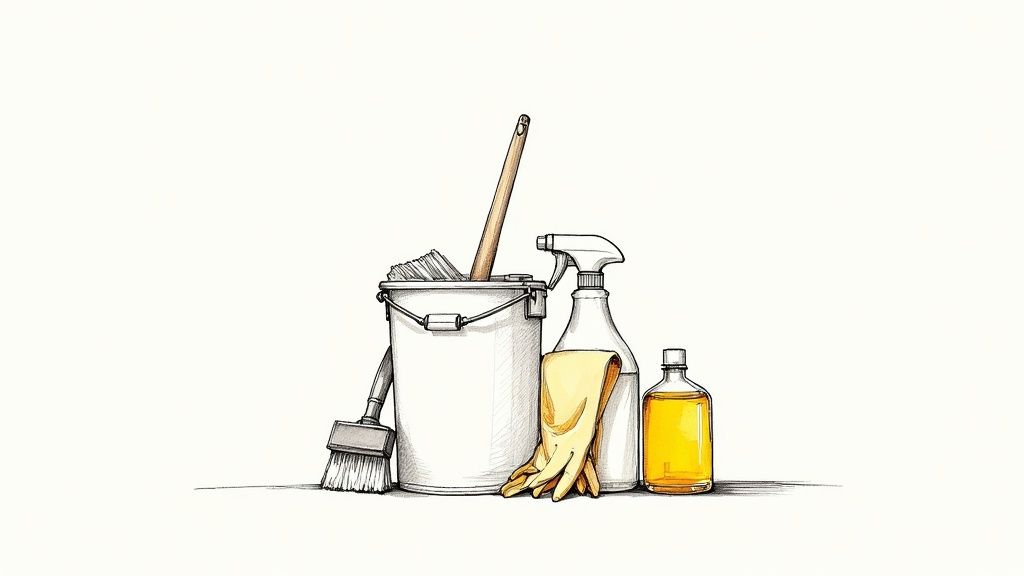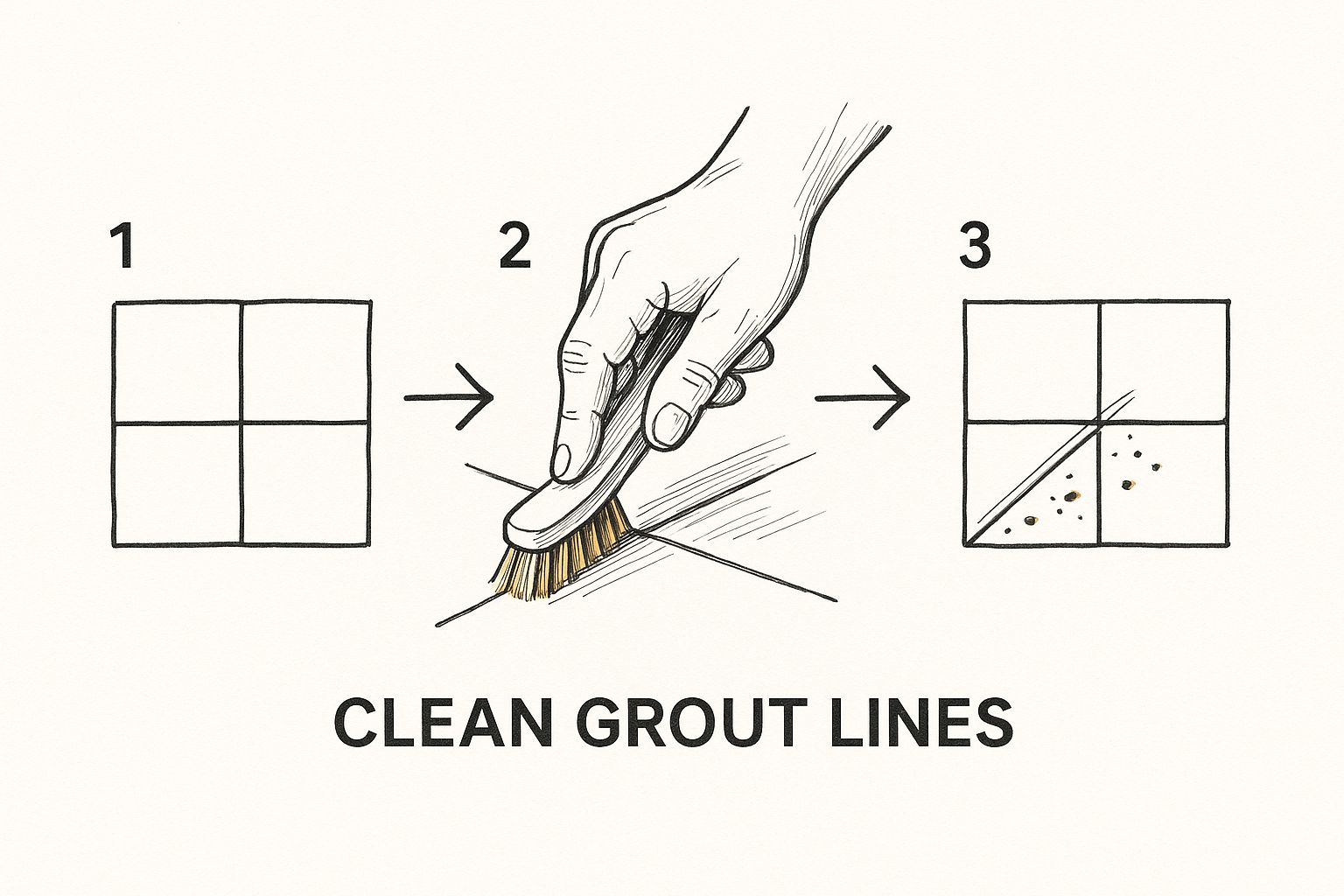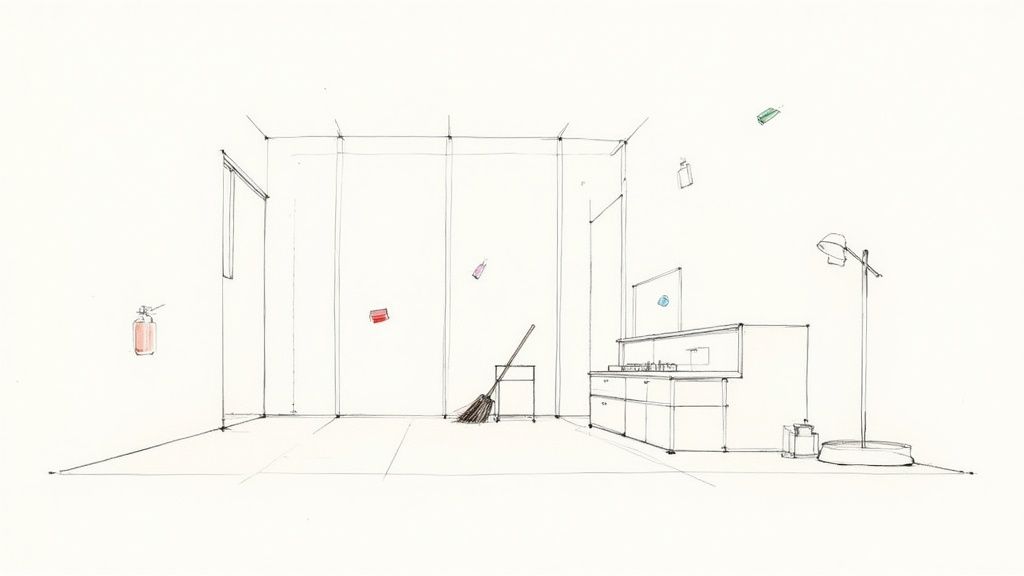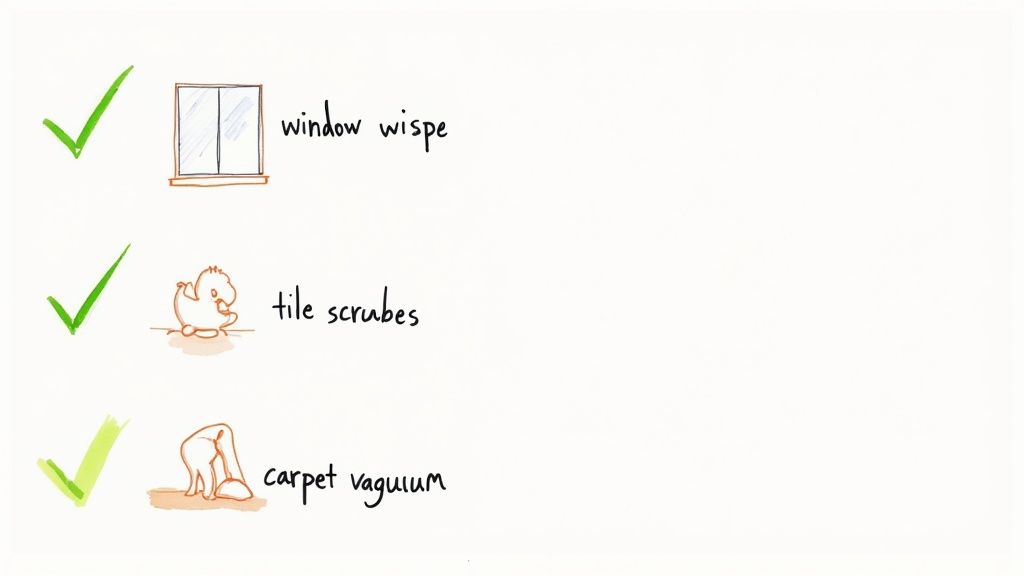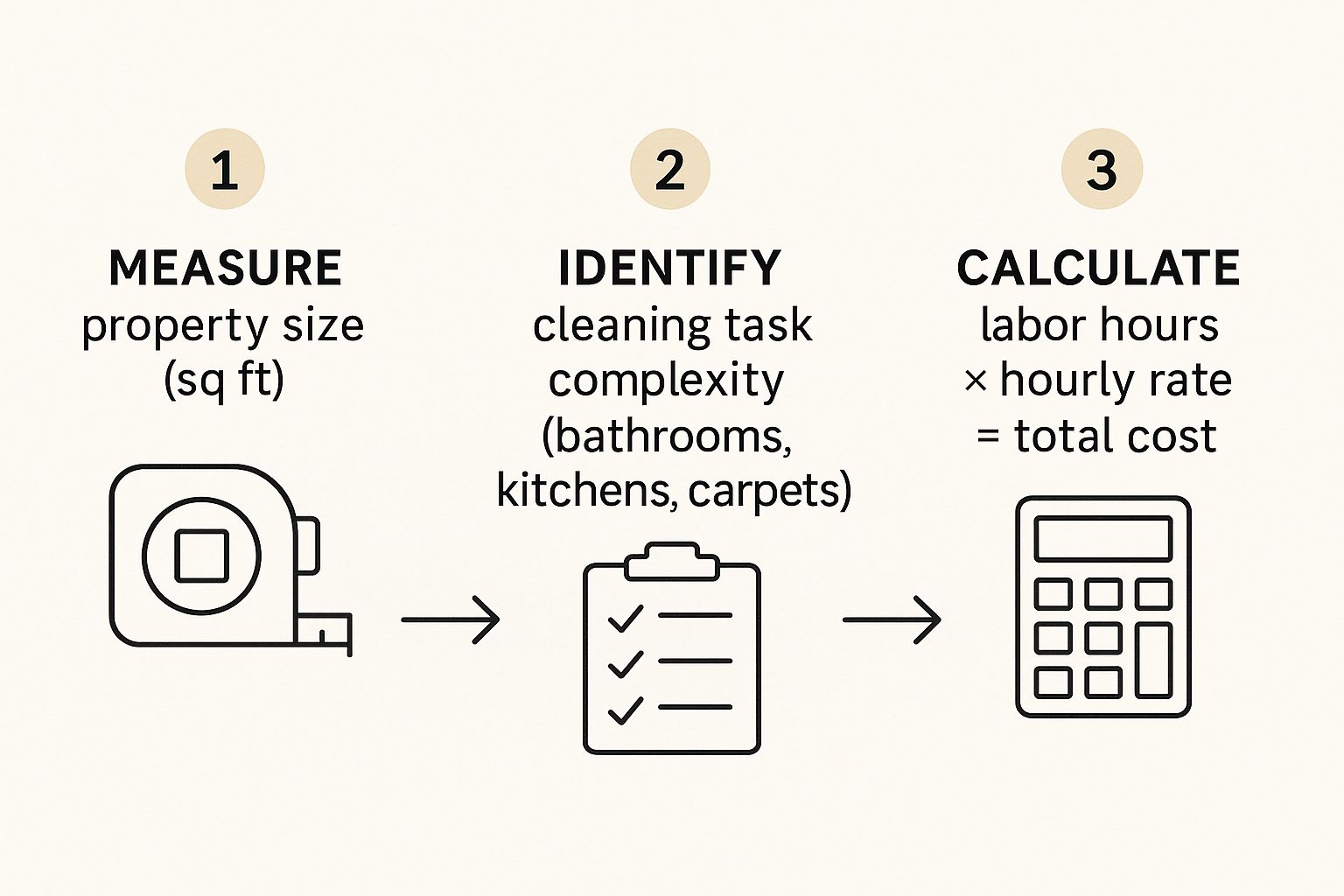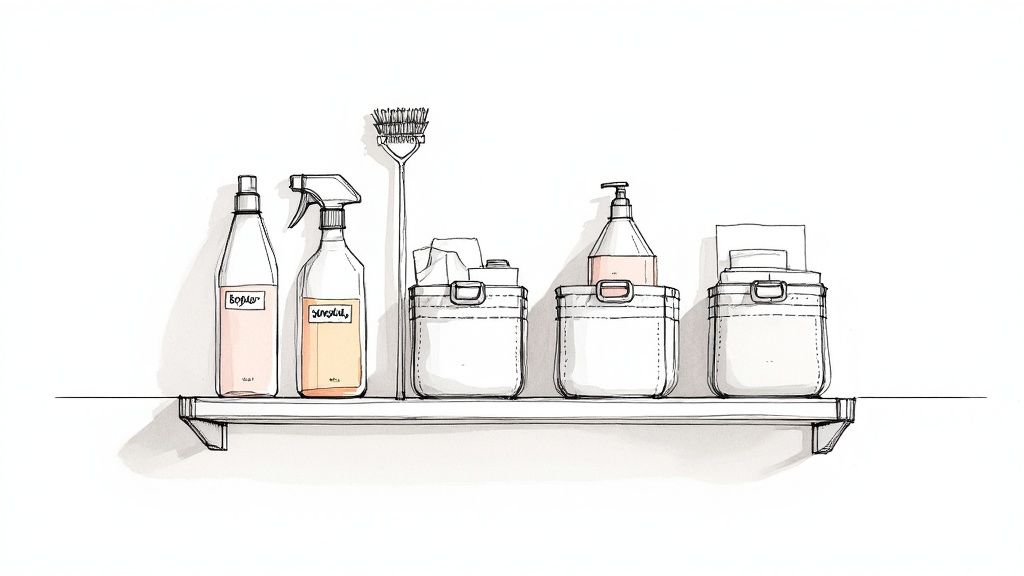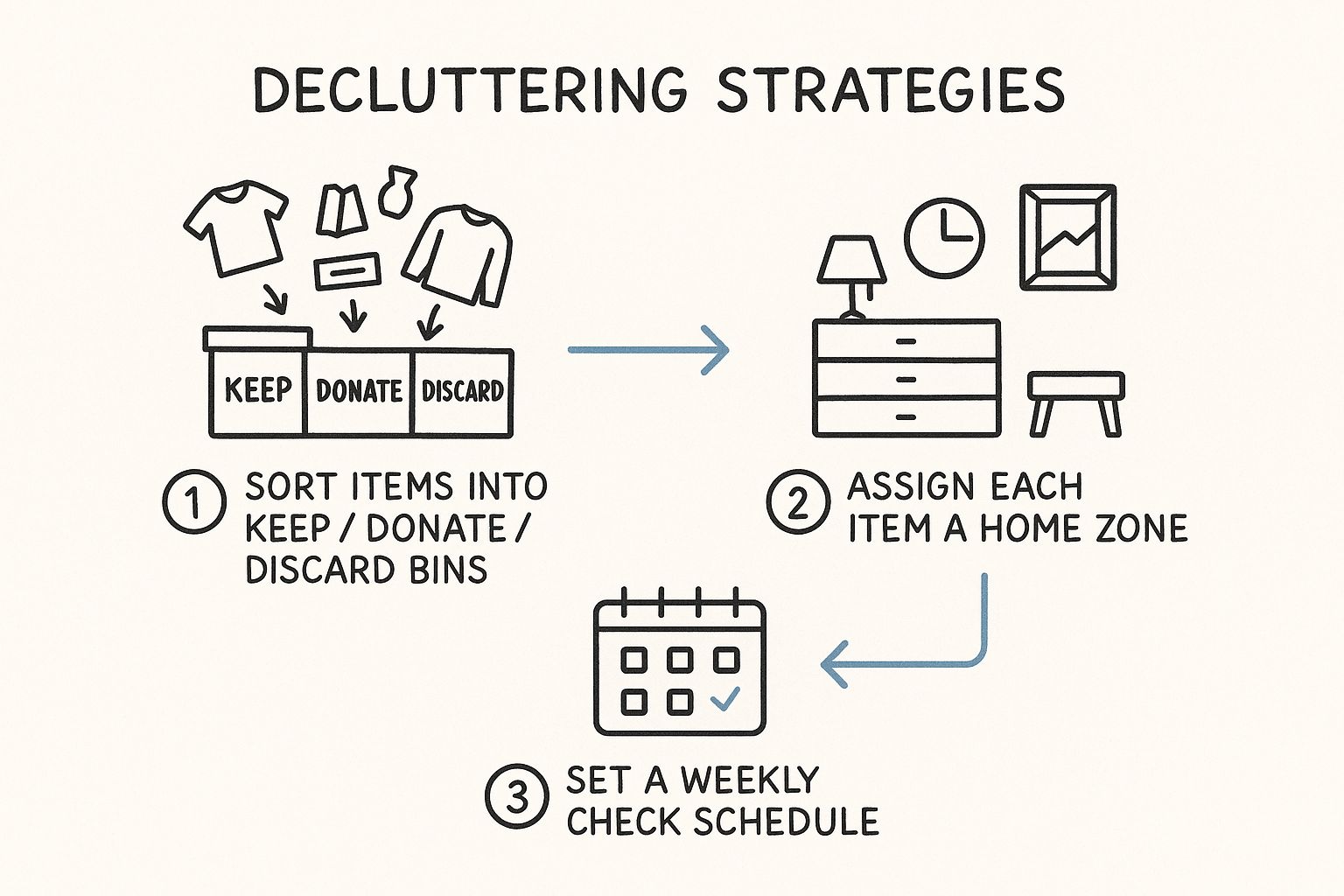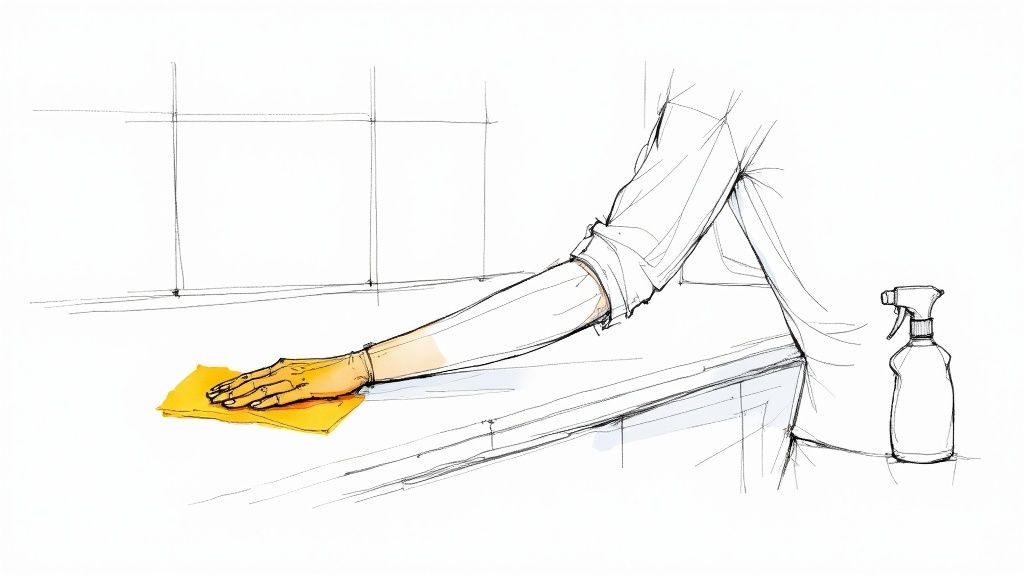Before you even think about posting an ad or calling an agency, the first step is to get crystal clear on what you actually need. Finding a good housekeeper in the UK starts with figuring out the specific jobs you want them to do, because the role often goes far beyond a simple clean.
Defining Your Actual Housekeeping Needs

It’s easy to use "cleaner" and "housekeeper" as if they mean the same thing, but they really don't. A cleaner handles the surface-level stuff, while a true housekeeper helps manage the home itself. Getting this distinction right from the get-go is the most important part of the process.
Nailing down your requirements prevents a world of misunderstanding down the line. It ensures you attract people with the right skills and saves you from hiring someone who's either overqualified and pricey or underqualified and unable to keep up.
Moving Beyond Basic Cleaning
Take a moment to think about the real rhythm of your home. Are you constantly buried under a mountain of laundry? Do you need a hand with the weekly food shop or someone to be in for deliveries? These are classic housekeeping tasks, not standard cleaning.
I always recommend making a detailed checklist. It’s a simple exercise, but it forces you to visualise the role properly and helps you write a much better job description.
Your list might include things like:
- Deep Cleaning: This is the stuff that goes beyond a quick wipe-down, like scrubbing the oven, washing internal windows, or tackling stubborn limescale. For more tips on this, our guide on how to remove stubborn stains has some great advice.
- Laundry Management: Are we talking a simple wash and dry, or do you need ironing, folding, and putting everything away in wardrobes?
- Household Errands: This could be anything from picking up the dry cleaning and posting parcels to doing the big weekly shop.
- Pet Care: Does the dog need walking? Do the cats need feeding? Maybe even arranging vet appointments.
- Light Meal Prep: Perhaps you need someone to prep simple family meals or get the kids' packed lunches ready for school.
By mapping out every potential task, you create a clear scope of work. This not only helps you find the right person but also allows you to set a fair and competitive salary.
Tailoring to Your Home and Lifestyle
Naturally, the size of your home and your family's lifestyle will play a huge role here. A sprawling family home with three kids and a dog has completely different demands than a two-bedroom flat owned by a busy professional. You have to be realistic about the hours needed.
For instance, a busy family might need someone for 20 hours a week to stay on top of daily tidying, laundry, and maybe even help with the school run. On the other hand, a couple might only need 10 hours a week for a thorough clean, ironing, and general organising.
Being upfront about these expectations from the start makes it so much easier to find a housekeeper who genuinely fits into your life.
Where to Find a Great Housekeeper in the UK
Right, you’ve got your list of duties sorted. Now for the big question: where do you actually find someone reliable?
It’s a bustling market out there. The UK cleaning industry is huge, employing around 1.47 million people and worth nearly £60 billion. That means you’ve got options, but you need to know where to look to find the real gems.
When you start digging into how to find a housekeeper, you'll see a few common paths emerge. Each one has its own set of pros and cons, catering to different needs and how hands-on you want to be in the search.
The chart below gives a good snapshot of where most homeowners in the UK kick off their search.
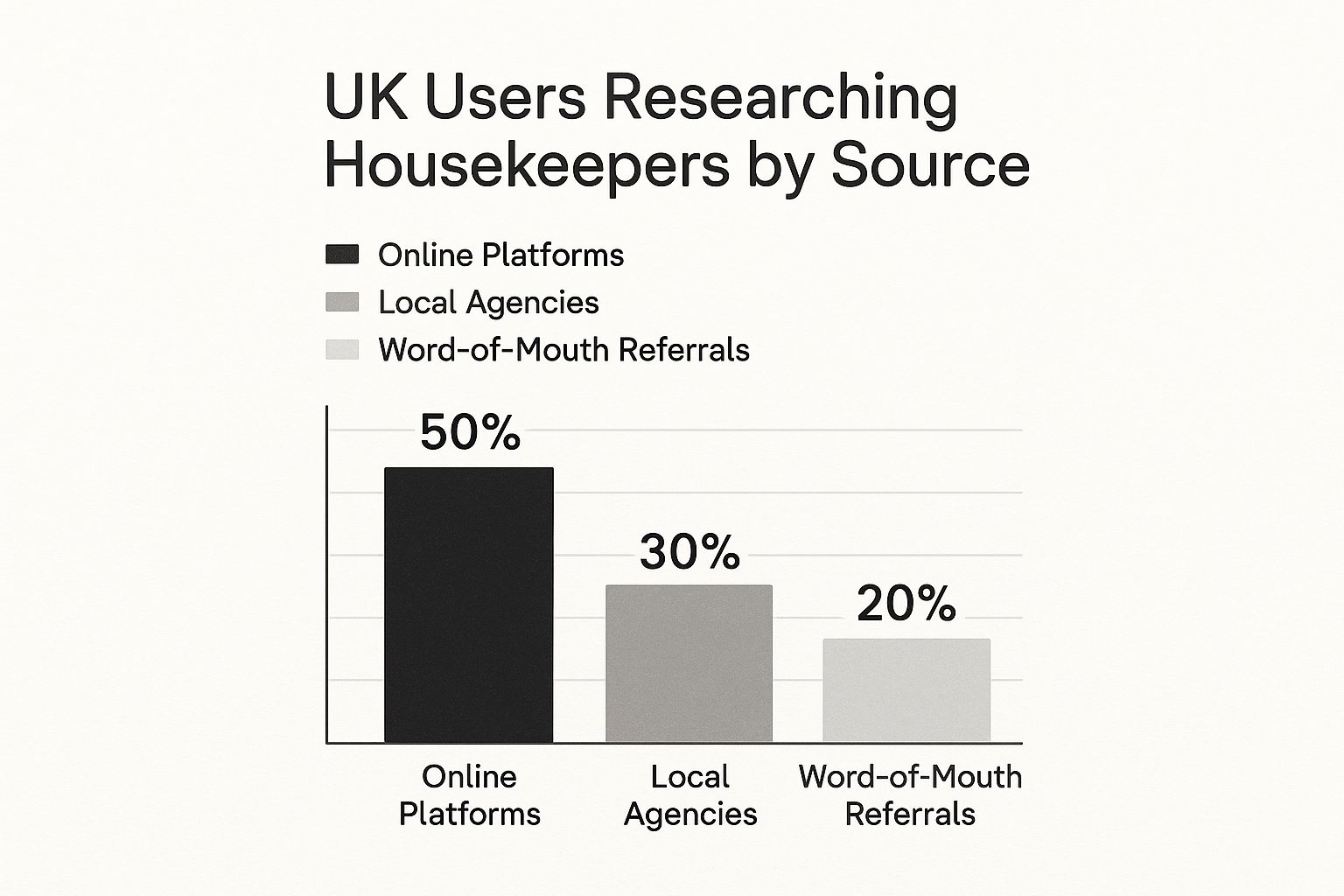
As you can see, online platforms are the go-to for most, but plenty of people still value the old-school routes like agencies and personal recommendations—and for good reason when you’re inviting someone into your home.
Let's break down your main options so you can figure out which path is right for you.
Comparing Your Housekeeper Search Options
To make sense of it all, here’s a quick comparison of the three main ways you can find a housekeeper in the UK.
| Method | Pros | Cons | Best For |
|---|---|---|---|
| Specialist Domestic Agencies | Vetted candidates, handles all checks, saves you time, high-calibre professionals. | Expensive placement fees, smaller pool of candidates, can feel a bit formal. | Busy professionals who need a fully vetted, experienced housekeeper with minimal fuss. |
| Online Platforms & Job Boards | Huge pool of candidates, more control over hiring, cost-effective, direct communication. | Very time-consuming, you do all the vetting, can be a bit of a lottery. | People who are happy to manage the hiring process themselves and want a wide choice of applicants. |
| Word of Mouth & Community | Highly trusted referrals, proven reliability, candidates are often local. | Can be slow, limited options, relies on your personal network. | Anyone who values a personal recommendation above all else and isn't in a major rush. |
Each route can lead you to a fantastic housekeeper, but the journey to get there is quite different.
Specialist Domestic Staff Agencies
If you want the gold standard in vetting and have very little time to spare, a specialist agency is your best bet. Think of them as recruiters for your home. They do all the heavy lifting: advertising the role, sifting through applications, conducting initial interviews, and carrying out extensive background and reference checks.
The biggest advantage here is the peace of mind. You’ll be presented with a small, carefully curated list of highly experienced professionals. The trade-off? It’s the most expensive option. Agencies typically charge a hefty placement fee, often calculated as a percentage of the housekeeper’s annual salary.
Online Platforms and Job Boards
This is where the majority of people start, and for good reason. Websites like Gumtree, Indeed, and other specialised domestic help sites give you direct access to a massive pool of potential candidates. You’re in the driver's seat for the entire process.
You'll be responsible for writing a compelling job advert, filtering the applications, arranging interviews, and checking references yourself. It's definitely more work, but it’s a much cheaper route. This path is ideal if you’re confident in your hiring skills and want to have the final say on every detail.
The secret to success on these platforms? A crystal-clear job advert. Be incredibly specific about the duties, hours, location, and the kind of person you think would be a good fit. It’ll help you attract serious, high-quality applicants from the start.
Of course, if you’d rather skip the recruitment marathon entirely, you can always book a professional cleaning service online in just a few clicks.
Word of Mouth and Community Boards
Never, ever underestimate the power of a good old-fashioned recommendation. Asking friends, family, or neighbours is still one of the most reliable ways to find a housekeeper you can trust. A referral comes pre-vetted, in a way, because the person has already proven themselves in a home you know.
Don’t forget to check local resources, too. Community Facebook groups or even notice boards in local shops and community centres can be goldmines, particularly in smaller towns. This hyperlocal approach often turns up great candidates who live just around the corner, which is a huge plus for reliability and building a long-term working relationship. It's a low-tech strategy that thrives on community trust.
Budgeting for Housekeeper Salaries and Costs

Right, let’s talk money. Getting the financial side of things sorted from the get-go is probably the most important step for making this whole process a success. Before you can even think about making an offer, you need a realistic idea of what the role is worth in today’s market.
Several big factors will shape the salary, and understanding them now will save you from any nasty surprises down the line. The three main drivers are always location, whether the role is live-in or live-out, and the specific duties you need them to perform. It's common knowledge that wages in London and the South East are considerably higher than elsewhere in the UK—often by 15-20%—to account for the steeper cost of living.
Understanding Typical Salary Ranges
When you start to find a housekeeper in the UK, having some benchmark figures in your head is a huge help. A full-time, live-out housekeeper covering a wide range of tasks will command a salary that reflects both their experience and the local pay scale.
For example, in London, a live-in housekeeper might expect to earn between £30,000 and £50,000 a year. Interestingly, their live-out counterparts often earn a little more, typically from £35,000 to £55,000, to cover their own rent, bills, and travel costs. You can always check out more detailed salary guidelines to get a better feel for the market.
A competitive salary doesn't just attract more candidates; it attracts better candidates. Offering a fair wage that reflects the role's demands and the local market is the best way to find a skilled and committed professional who will stay with you long-term.
To give you a clearer picture, here’s a quick summary of what you might expect to pay for a full-time professional.
Typical UK Housekeeper Salary Ranges (Annual)
This table outlines the average salary expectations for full-time housekeepers across the UK. Remember that these are just guides—a candidate with specialist skills or extensive experience may command a higher salary.
| Role Type | London & South East | Rest of UK |
|---|---|---|
| Live-In Housekeeper | £30,000 – £50,000 | £28,000 – £40,000 |
| Live-Out Housekeeper | £35,000 – £55,000 | £30,000 – £45,000 |
| Part-Time Housekeeper (Hourly) | £17 – £25+ per hour | £15 – £20 per hour |
These figures are a brilliant starting point, but always be prepared to adjust them based on the specific skills and level of experience you’re looking for.
Looking Beyond the Basic Salary
The agreed salary is just one piece of the puzzle. When you employ a housekeeper directly (as opposed to hiring a self-employed cleaner), you become an employer in the eyes of the law. This comes with responsibilities, and forgetting to budget for them can cause some real financial and legal headaches.
Make sure you factor these crucial on-costs into your budget:
- Employer's National Insurance: You’ll need to pay these contributions for your employee if their earnings are above the official threshold.
- Workplace Pension: If your housekeeper is eligible for auto-enrolment (and most are), you are legally required to contribute to their pension scheme.
- Employers' Liability Insurance: This is non-negotiable and a legal must-have for UK employers. It protects you if your housekeeper is injured or falls ill because of their work for you.
- Paid Holiday: Every employee is entitled to a minimum of 5.6 weeks of paid holiday each year. This is calculated on a pro-rata basis for part-time staff.
Accounting for these extras from day one gives you the true cost of employment. It’s the best way to build a professional, respectful, and sustainable relationship with your new housekeeper.
Vetting Candidates You Can Trust
Right, you’ve sorted through the initial applications and have a handful of promising people lined up. This is where the real work of finding the right person begins. A polished CV can tell you one story, but discovering a housekeeper who is genuinely trustworthy and reliable for your UK home takes a bit more digging.
Remember, you’re inviting someone into your personal space. It's a big deal. The interview is your chance to get a real sense of their character, attitude, and how they handle the unexpected—things a piece of paper just can't show you. Don't be shy about moving past the standard questions.
Asking Insightful Interview Questions
The goal here is to see how a candidate thinks on their feet. Instead of just running through a list of duties, try framing your questions around real-life scenarios. This approach is far more revealing about their professionalism and integrity.
Consider throwing in a few questions that go a bit deeper:
- "Tell me about a time you had to deal with a sudden household problem, like a leak or a broken appliance. What steps did you take?"
- "Let’s imagine you accidentally broke a small, inexpensive item. What would you do?"
- "How do you manage your time and prioritise tasks on a really busy day when it’s clear you won't get to everything?"
- "What's your approach to getting feedback? Can you give me an example of how you’ve adjusted your work based on what an employer preferred?"
The answers to these kinds of questions are incredibly telling. You're not just looking for someone who can clean; you're looking for honesty, clear communication, and a bit of initiative. Someone who explains a calm, practical approach to a problem is often a much better bet than someone with years of experience but questionable judgement.
A great housekeeper is a problem-solver who takes initiative. Listen for answers that show they can think independently and communicate clearly, especially when things don't go according to plan.
Conducting Meaningful Reference Checks
Whatever you do, don't skip the reference checks. This is your best opportunity to confirm what a candidate has told you and spot any potential red flags before it’s too late. When you get a previous employer on the phone, be prepared with a few solid questions.
Try to go beyond just confirming dates of employment. Open-ended questions will give you much more valuable insight.
For instance, you could ask:
- "Could you tell me a bit about their reliability and timekeeping?"
- "How did they respond to constructive feedback or any changes to the daily routine?"
- "Was there anything you felt they were particularly brilliant at around the home?"
- "Would you rehire them without a second thought?"
That last question is often the most revealing. Any hesitation or a qualified "yes" is your cue to probe a little further. Honest, direct feedback from someone who has been in your shoes is priceless. It gives you that final layer of confidence before making an offer.
In 2025, the demand for skilled housekeepers in the UK remains notably strong, with salary expectations reflecting both experience and the nature of employment. Recruitment data shows typical housekeeper salaries range between £35,000 and £45,000 annually for standard roles. You can discover more insights about 2025 domestic staff salary trends from Domestic Bliss Appointments.
Getting to Grips with Your Legal Duties as an Employer

Here’s a crucial distinction: when you hire a housekeeper directly, you’re not just a client—you become their employer. This shift changes everything in the eyes of the law, and it comes with a specific set of responsibilities you need to get right from the very beginning.
It might sound a bit intimidating, but honestly, it’s a straightforward process once you know the steps. Getting this sorted protects both you and your housekeeper, setting the foundation for a professional and respectful relationship. It all starts with one key document: a formal employment contract.
Why a Proper Contract is Non-Negotiable
A contract isn't just a formality; it’s a legal requirement that provides clarity and security for everyone involved. It’s your opportunity to get everything down in black and white, so there are no misunderstandings or awkward conversations down the line. Think of it as the instruction manual for your working relationship.
This document needs to include what's officially called a "written statement of employment particulars."
Make sure yours covers:
- The Job Description: A really clear list of every task you expect them to handle.
- Working Hours: Pinpoint the exact days and times they'll be working.
- Rate of Pay: The agreed wage and when they can expect to be paid (e.g., weekly, monthly).
- Holiday Entitlement: How much paid time off they get. The legal minimum is 5.6 weeks a year.
- Notice Periods: How much notice either of you needs to give to end the arrangement.
A solid contract is your best friend if a disagreement ever crops up. It means everyone knows exactly where they stand on everything from sick pay to disciplinary procedures.
Sorting Out HMRC and Payroll
Once you've found your perfect housekeeper and they've accepted the job, your next move is to register as an employer with HMRC. This needs to be done before their first payday. Registering allows you to manage their tax and National Insurance contributions through the PAYE (Pay As You Earn) system.
The thought of running payroll can feel a bit daunting, I know. The good news is there are plenty of user-friendly payroll services designed specifically for people employing staff at home. These platforms do the heavy lifting for you—calculating deductions, creating payslips, and sending all the right info to HMRC.
You'll also need to think about a workplace pension. If your housekeeper meets the criteria for auto-enrolment, you're legally required to set one up. This just means choosing a pension provider and making regular contributions. Taking these legal duties seriously from the outset is a core part of learning how to find a housekeeper in the UK the right way.
Answering Those Lingering Questions About Hiring a Housekeeper
Even with the best plan in place, hiring someone to work in your home for the first time can feel a little daunting. A few last-minute questions always seem to pop up, and that’s perfectly normal. Let's clear up some of the most common queries so you can move forward with confidence.
First up, a crucial distinction: are you hiring a self-employed cleaner or directly employing a housekeeper? A self-employed cleaner is a business owner. They usually work for several clients, bring their own supplies, and handle their own taxes. You’re simply a customer buying their service.
Hiring a housekeeper directly, especially for a set number of hours each week, often makes you their employer. This changes everything. Suddenly, you’re responsible for things like PAYE, pension contributions, and providing a proper employment contract. Getting this right from the start is non-negotiable for staying on the right side of the law.
What Kind of Insurance Do I Need?
This is a big one, and it’s something you absolutely can't afford to get wrong. If you become an employer, UK law requires you to have Employers' Liability Insurance. Full stop.
This insurance covers you if your housekeeper is injured or falls ill because of the work they do in your home. Don't assume your standard home insurance has you covered—it almost certainly doesn't. You'll likely need to add it to your policy or take out a separate one. It’s a small price to pay for total peace of mind.
If you’re hiring a self-employed cleaner, the shoe is on the other foot. They should have their own Public Liability Insurance. Don't be shy about asking to see proof of their policy before they start work.
How Should I Run a Trial Period?
A trial period is a fantastic idea. It’s your chance to see if you’ve found the right person before you make a long-term commitment. Think of it less as a test and more as a "getting to know you" phase for both of you.
Be upfront about it and make sure it’s a paid arrangement, usually lasting between two and four weeks.
During the trial, pay attention to a few key things:
- Communication: Are your instructions understood? Do they ask questions if they’re unsure about something?
- Job Performance: Are the tasks you agreed on being done to a standard you're happy with?
- Professionalism: Are they punctual, reliable, and pleasant to have in your home?
A great trial period isn't about catching someone out. It’s built on clear expectations and friendly, open feedback. This is your first opportunity to build a solid working relationship.
Providing Feedback and Maintaining a Great Relationship
The secret to keeping a great housekeeper for years? Open and respectful communication. It’s that simple. Don’t let little annoyances fester until they become major issues. A quick, friendly chat every couple of weeks can make all the difference.
When you do give feedback, keep it constructive. Instead of saying, "You missed the skirting boards," try something like, "Could we put the skirting boards on the priority list for next time?" It’s a small shift in language, but it frames the conversation collaboratively. For more tips on managing your home and building professional relationships, feel free to explore the different topics on our main blog.
Finally, remember the little things. Offering a cup of tea or being a bit flexible if they have a personal appointment goes a long, long way. A housekeeper who feels valued and respected is one who will be motivated to do their very best for you.
Ready to skip the hiring process and enjoy a spotless home without the hassle? The team at Signal Cleaning offers professional, reliable cleaning services across Oxford. Book your clean online in just a few clicks!
